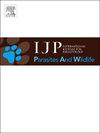Statewide surveillance of tick-borne pathogens in ticks collected in Delaware using novel multiplex PCR assays
IF 2
3区 医学
Q3 ECOLOGY
International Journal for Parasitology-Parasites and Wildlife
Pub Date : 2025-03-21
DOI:10.1016/j.ijppaw.2025.101058
引用次数: 0
Abstract
Tick-borne pathogens are responsible for most vector-borne human diseases in the United States. With the growing recognition of tick-borne diseases and the expanding range of ticks, it is imperative to understand which pathogens, and in what prevalence, are carried by tick species in areas populated by humans. Few studies exist surveying the presence and distribution of tick-borne pathogens in the state of Delaware. The goal of this study was to create multiplex real-time PCR assays to identify Borrelia burgdorferi sensu stricto, Babesia microti, Anaplasma phagocytophilum, Ehrlichia chaffeensis, and Ehrlichia ewingii from their respective tick vectors collected across the state of Delaware.
Two multiplex, real-time PCR assays were developed and tested on 1027 ticks comprising Ixodes scapularis and Amblyomma americanum, two species of ticks commonly encountered in Delaware. The results showed that in a sample of 500 Ixodes scapularis ticks, 30.20 % were positive for Borrelia burgdorferi, 2.60 % were positive for Babesia microti, and 1 % were positive for Anaplasma phagocytophilum. Testing of 527 A. americanum ticks showed that 4.74 % were positive for E. chaffeensis and 1.14 % were positive for E. ewingii. These findings suggest that these five tick-borne pathogens are present across the state of Delaware and therefore pose a risk to the public.
在特拉华州使用新的多重聚合酶链反应分析收集蜱传播病原体的全州监测
在美国,蜱传病原体是大多数媒介传播的人类疾病的罪魁祸首。随着人们越来越认识到蜱传疾病和蜱的范围扩大,有必要了解在人类居住的地区,蜱种携带的病原体和流行程度。在特拉华州很少有研究调查蜱传病原体的存在和分布。本研究的目的是建立多重实时PCR检测方法,从特拉华州收集的严格感伯氏疏螺旋体、微小巴贝斯虫、嗜吞噬细胞无形体、查菲埃利体和伊温埃利体蜱虫媒介中鉴定出相应的蜱虫。建立了两种多重实时PCR检测方法,并对1027种蜱进行了检测,其中包括在特拉华州常见的两种蜱——肩背硬蜱和美洲钝蜱。结果表明,500只棘蜱中伯氏疏螺旋体阳性率为30.20%,微巴贝斯虫阳性率为2.60%,嗜吞噬细胞无形体阳性率为1%。527只美洲蜱检测结果显示,沙非伊蚊阳性率为4.74%,伊温伊蚊阳性率为1.14%。这些发现表明,这五种蜱传病原体存在于整个特拉华州,因此对公众构成了风险。
本文章由计算机程序翻译,如有差异,请以英文原文为准。
求助全文
约1分钟内获得全文
求助全文
来源期刊

International Journal for Parasitology-Parasites and Wildlife
Medicine-Infectious Diseases
CiteScore
3.80
自引率
5.60%
发文量
113
审稿时长
45 days
期刊介绍:
The International Journal for Parasitology: Parasites and Wildlife (IJP-PAW) publishes the results of original research on parasites of all wildlife, invertebrate and vertebrate. This includes free-ranging, wild populations, as well as captive wildlife, semi-domesticated species (e.g. reindeer) and farmed populations of recently domesticated or wild-captured species (e.g. cultured fishes). Articles on all aspects of wildlife parasitology are welcomed including taxonomy, biodiversity and distribution, ecology and epidemiology, population biology and host-parasite relationships. The impact of parasites on the health and conservation of wildlife is seen as an important area covered by the journal especially the potential role of environmental factors, for example climate. Also important to the journal is ''one health'' and the nature of interactions between wildlife, people and domestic animals, including disease emergence and zoonoses.
 求助内容:
求助内容: 应助结果提醒方式:
应助结果提醒方式:


